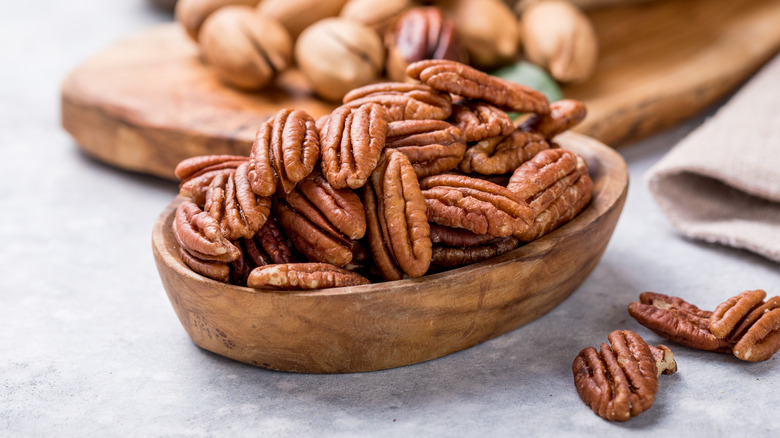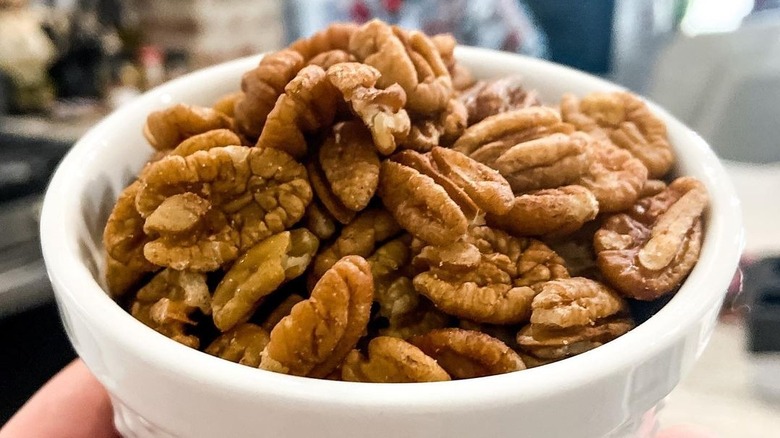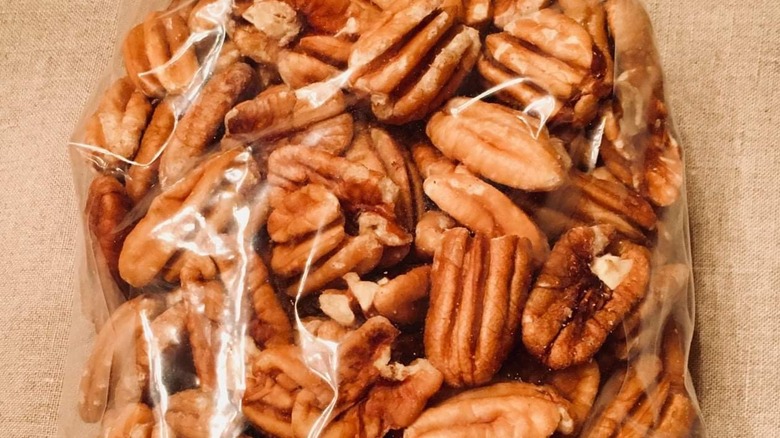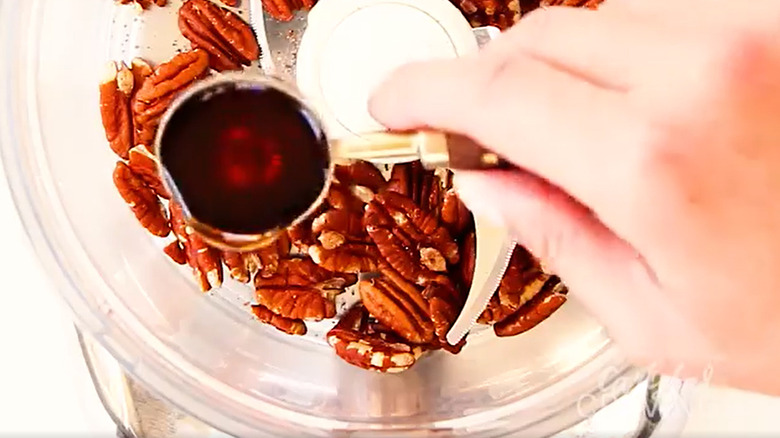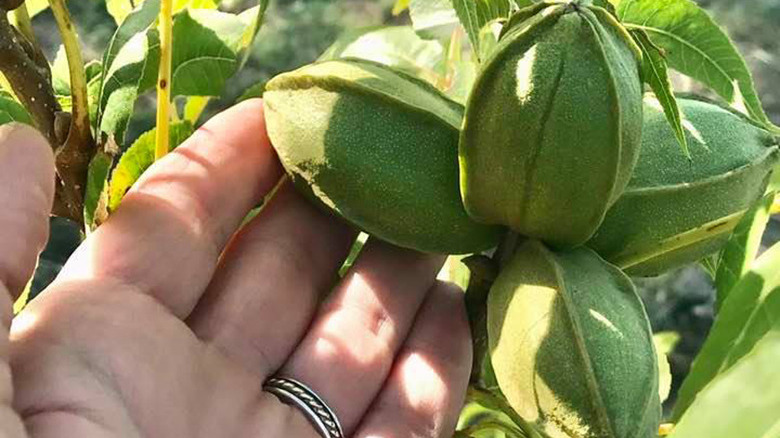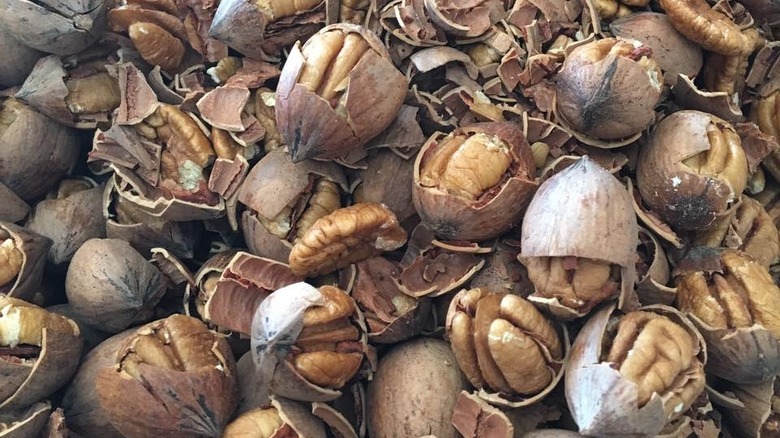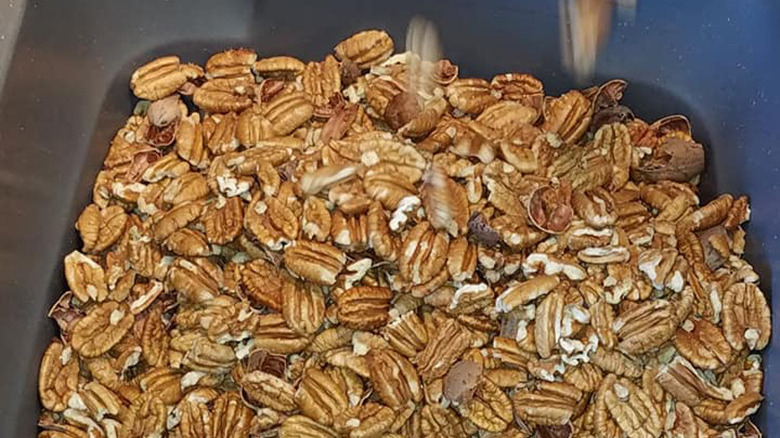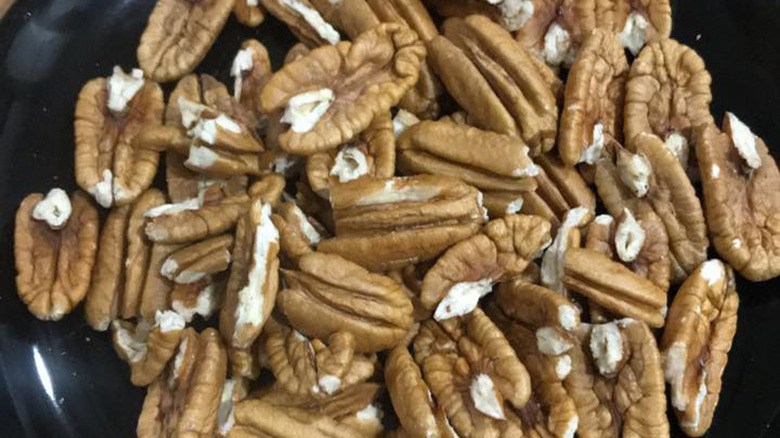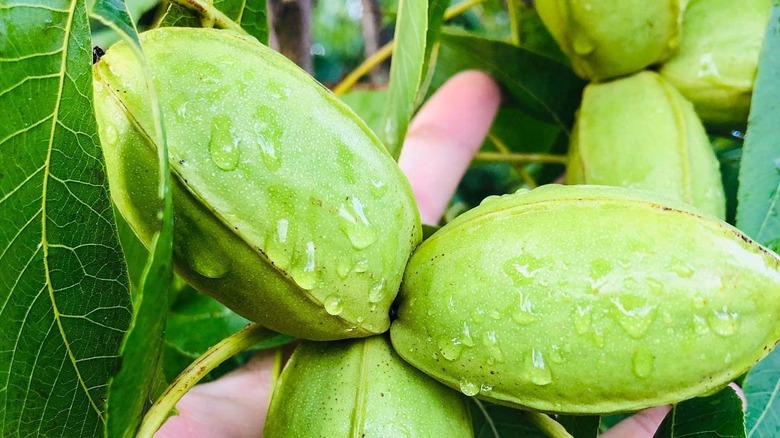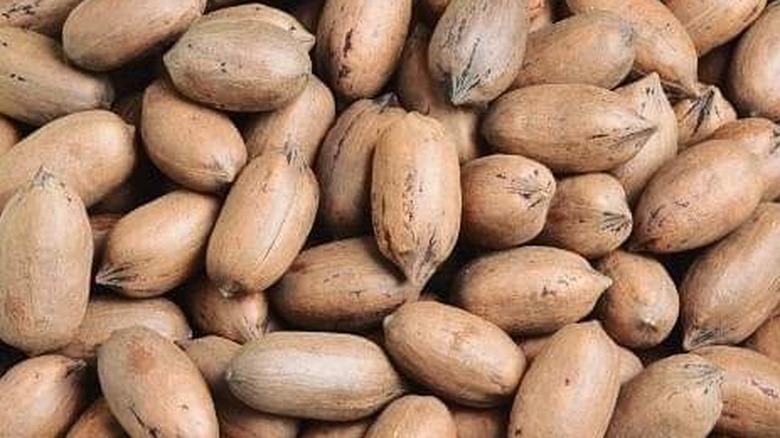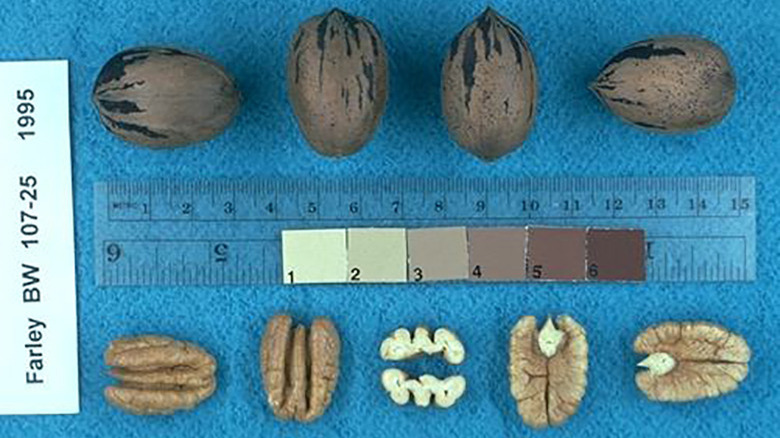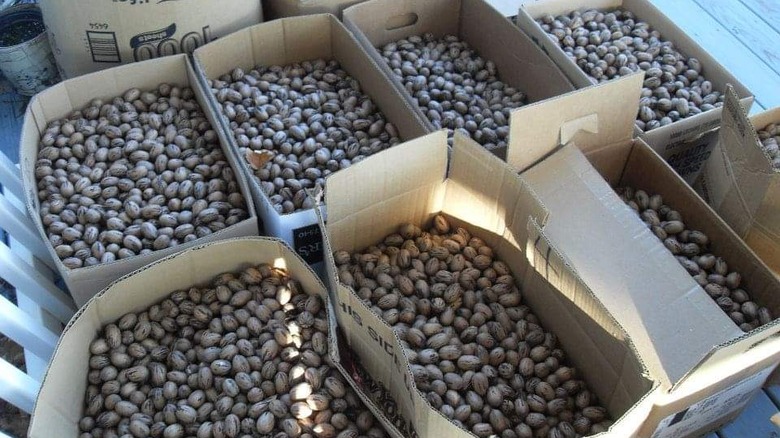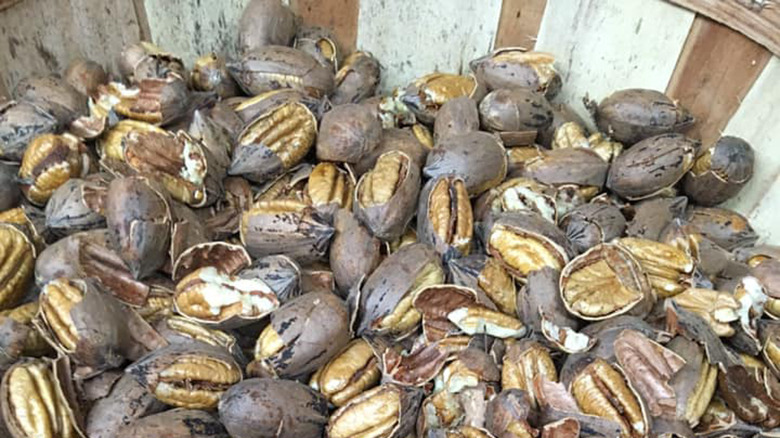12 Types Of Pecans To Try In Your Summer Salads
Okay, let's talk about the elephant in the room: How do you pronounce pecan? Well, there are actually three official ways to say this nut's name. For some, it's a combination of the word "peak" and the name Ann. For others, the "pe" part of pecan is pronounced more like the "pi" in pick. And for still others, the "can" part is pronounced like Ricardo Montalbán's titular character from the movie "Star Trek: Wrath of Khan." So, technically, you can say "Peak Ann," "pick Ann," or "pick Khan."
No matter how you pronounce pecan, one thing remains the same: Pecans are popular nuts that are used to add flavor to a variety of dishes such as salads. They are also packed with nutritional benefits. According to the National Pecan Shellers Association, pecans contain high amounts of antioxidants, making them beneficial for people with conditions like coronary heart disease, Parkinson's, Alzheimer's, and even cancer. Pecans are also a good source of vitamins, minerals, and protein.
"But wait," you might ask, "don't pecans contain fat?" Yes, they do, but they contain monounsaturated fatty acids, which may aid heart health. Pecans are a cholesterol-free food. And, despite them being associated with the holidays, technically, pecans are a year-round food, making them great for summertime. Luckily, there are plenty of choices for pecan lovers. According to Millican Pecan, there are hundreds of varieties of this little nut, and each type has its own characteristics and purpose.
Wild native pecans
As Millican Pecan explains, the history of wild native pecans dates back to the 16th century. At that time, travelers from Europe were exploring North America and came across these pecans. Wild pecans tend to grow near riverbanks and trees. While native pecan trees in orchards are planted 30 feet apart and are spaced out in perfect lines, in the wild, these trees grow wherever an animal, a river, or the wind has deposited a seed.
Wild native pecans differ from other nut varieties in several different ways: For one, they tend to have a notably nuttier taste than some other pecans. They also tend to be smaller in size and golden in color. They are great for salads, as well as pies and candies. However, there is one drawback: Since they have a very hard shell and are relatively smaller in size, cracking them can be a challenge.
Cape Fear pecans
For many, the first thing that comes to mind when they hear the name "Cape Fear" is the 1991 movie that stars Robert De Niro and Nick Nolte. However, Cape Fear pecans predate this thriller by around 50 years. As Millican Pecan explains, Cape Fear pecans were developed by farmers and made available to customers in the 1930s.
Cape Fear pecans don't weigh as much as some other pecans types because they have thin shells. Like other pecans on this list, Cape Fear pecans are golden in color, making them an attractive addition to a nice green salad. They also have a rich flavor. However, the flavor and quality of pecans can be severely diminished if the pecan tree contracts a disease known as pecan scab: According to The American Phytopathological Society, this illness can reduce how many nuts a pecan tree produces and lead to smaller nuts that stick to the shell and are more prone to infections like pink mold fungus.
Fortunately, the NC State Location states that Cape Fear trees are resistant to pecan scab. So, there's no need to fear if you buy Cape Fear pecans. Odds are you'll have a flavorful ingredient for your salad that has an easy-to-remove shell.
Candy pecans
Candy pecans are not the same as candied pecans. According to Willis Orchards, this variety of pecans gets its name because of its flavor. The sweet taste of these pecans makes them a great choice for candies and fruit cakes. But don't let that discourage you from throwing them into a salad. Although these pecans are good for cooking, that doesn't mean they can't be enjoyed raw.
Besides their flavor, these pecans have extremely thin shells, making them conveniently easy to crack. And they have another major perk: Some pecan trees don't have a large harvest of nuts every year. Candy pecan trees consistently produce nuts high-quality nuts year after year.
Like other varieties, these pecans ripen in the fall. They generally become available in October. But don't worry. You can still have these nuts for your summer salad. Yes, you might need to do a little net surfing, but these sweet, thin-shelled pecans are available even if October is months away. Whichever variety of pecan you're after, don't be afraid to do your research and go the extra mile.
Moreland pecans
Imagine for a moment that you want to plant flowers in your backyard; however, one species of flower you're considering is only going to grow well in certain areas of the yard, while others can flourish anywhere in the yard. Chances are, you'd choose the flower that will do well no matter where you plant it in your backyard. The same holds true for Moreland pecans.
As the American Society for Horticultural Science explains, it's unusual for pecans to do well in places where the humidity is consistently high. For example, in the state of Louisiana, the humidity makes it challenging to grow pecans. Moreland pecans, though, thrive in Shreveport, Louisiana. They have thin brown shells and black streaks. The edible part of the pecan is a light yellow color, which makes it a pleasingly colorful addition to salad, especially one with dark leafy greens.
Moreland pecan trees tend to do well both in terms of the number of nuts they produce and the quality of the kernels of the pecans. Additionally, while some pecan trees produce empty pecan shells or pops, Moreland pecan trees do not, which makes them even more convenient and easy to cultivate.
Elliot pecans
A child of the '80s might think these next pecans are named after the little boy from the movie "E.T. the Extra-Terrestrial," but this isn't the case: Firstly, the character in the film is named Elliott, not Elliot (although some sources spell Elliot pecans as "Elliott" pecans). And secondly, according to NatureHills.com, these pecans are named after Henry Elliot, who discovered them in the first part of the 1900s.
There are a few things to keep in mind when it comes to Elliot pecans: As Willis Orchards explains, Elliot pecans tend to be smaller in size. So, you'll need more of them to give your summer salad an extra crunch. Also, their shells tend to be thicker as compared to the shells of some other pecan varieties. But don't let that put you off these pecans. Once you break the motley shell of this pecan, you'll find a tear-shaped nut that has a hickory flavor. So, Elliot pecans not only give your salad a pleasant touch of flavor, but they also work well in other dishes like desserts and hors d'oeuvres.
Besides their flavor, Elliot pecans have some big benefits in terms of production. While some pecan trees produce varying quantities of pecans each year, Elliot pecan trees tend to produce the same amount of pecans each year. These trees are also more consistent in the size of the pecans they produce as opposed to other trees. They're also more resistant to drought and pecan scab.
Desirable pecans
Certain foods have highly appealing names: Red Delicious apples, for example. Or the Desirable pecan. According to the University of Georgia, the Desirable pecan is grown in the Southeastern part of the United States and is a standout pecan in terms of quality.
Desirable pecan trees are more likely to get a disease called pecan scab, which can negatively affect the pecans. And yet, despite this fact, Desirable pecan trees still tend to grow high-quality pecans on an annual basis.
If there was such a thing as a work-life balance for trees, these pecan trees would be experts at it: They pull back on how many clusters of nuts they produce, allowing them to reduce their stress levels and produce pecans consistently. This variety tends to produce larger-sized pecans.
Besides, Desirable pecan trees regularly produce quality pecans that are packed with flavor (per Simpson Nursery). These are ideal for adding to a fresh salad, especially if it doesn't contain dressing. Plus, they make for a visually pleasing topping for your favorite dishes.
Oconee pecans
While some of the pecans on this list were discovered centuries ago, Oconee pecans are a more recent addition to the world of pecans. According to NatureHills.com, Oconee pecans first came on the scene in 1989. Oconee pecan trees regularly produce large amounts of nuts each October. These trees are resistant to cold, and they tend to grow in the Northern part of the U.S. in states like New Jersey, Oregon, and Washington State.
Furthermore, according to SFGate, both Oconee pecan trees and Desirable pecan trees tend to produce large, quality pecans. However, the Georgia Pecan Commission rates Desirable pecans as better than Oconee pecans for roasting. That being said, Oconee pecans' easy-to-remove shells make them a very convenient and tasty option for a healthy salad. Oconee pecans are not only super easy to break open, but they're also much more likely to appear in two unbroken halves, making them an easy and convenient addition to various dishes.
Kiowa pecans
This next pecan took years before it became available to the public. The Kiowa pecan tree was created in 1953, Kiowa pecans didn't appear on the markets until 1976. As Woodard's Farm and Nursey explains, the Kiowa pecan is a cross between two other varieties of pecan: The Mahan and the Desirable. Perhaps this is why Kiowa pecans are large and even look similar to Desirable pecans (via Clough Pecan Company). But there is a major difference between the two. The shells of Kiowa pecans are thinner than those of Desirable pecans. This makes them easier to crack.
Also, according to Millican Pecan, the kernels of the Kiowa pecans are a darker color when compared to some other pecans. Of course, there are some pros and cons regarding the Kiowa pecan tree. These pecan trees are usually high producers. However, unlike some of the other pecans on this list that can grow well in the Northern part of the United States, Kiowa pecan trees are more sensitive to the cold, which is why they grow best in places that are warm and humid.
Schley pecans
Schley pecans have something in common with the actor Sylvester "Sly" Stallone. According to The Pecan Nation, Schley is actually pronounced as "sly." And, as Brickyard Point Farms, LLC notes, the Schley pecan is an especially valued pecan variety.
There are two qualities that really set these pecans apart: For one, they have exceptionally thin shells, thus making them rather convenient to use. To put it another way, imagine you've had a long day at work and want to make a nice salad as part of your dinner. Do you want a literally hard nut to crack or something that's easier to break open? In all likelihood, you'd prefer the thin-shelled Schley pecans. These pecans are oily and packed with a strong burst of flavor.
Although Schley pecans have some positive traits, there is an important point to keep in mind if you decide to use these pecans: Schley pecans should be stored either in the refrigerator or the freezer to keep them from turning bad. So, you might want to keep Schley pecans and other ingredients you might use in a salad, such as fruits and vegetables, safely tucked away in the fridge.
Farley pecans
The early 1900's was a crucial time for the Farley pecans: According to Camp David Pecans, B.W. Soone of Stone Nursery Co. discovered Farley pecans in 1918. This variety hit the market in 1925. The specific parentage of Farley pecans remains unknown (via University of Georgia).
This mystery in the Farley pecans' past aside, these pecans have some noteworthy plus points: For example, Farley pecans have a sweet taste that's reminiscent of hickory. And their shells are thin, so the only equipment you'll need to crack these open are your hands. But these thin shells are also a bit of a downside.
Unfortunately, these thin shells make it easier for wildlife like birds to access the nuts. So, even though a Farley pecan tree might produce a good number of nuts, animals are likely to consume several before humans have a chance to harvest them.
These pecans can be difficult to find due to the wildlife factor and because they ripen later than other pecans. However, if you want a sweet, hickory taste for your summer salad, it might be worth the extra effort.
Stuart pecans
If you live in certain parts of the U.S., there's a good chance you're familiar with Stuart pecans. According to NatureHills.com, these pecans originated in Mississippi and are especially popular in Southeastern United States. Nevertheless, these pecans can grow in colder areas like parts of Maine, Washington State, or Oregon and are adaptable to many different types of soil.
Stuart pecan trees are lower maintenance and more durable than some other members of the pecan family. For example, as Willis Orchards notes, they don't require as much pruning. But even though Stuart pecan trees are easier to grow and maintain, they do take longer to produce nuts.
However, once they do, the pecans they make are both sweet and nutty in flavor with a nice crunchy texture (via Saveur). And they're a medium-sized pecan, giving you a bit more to work with per nut. Plus, they're good for various recipes like dirty rice and wedding cookies.
Pawnee pecans
Certain pecans varieties really stand out from the rest: Case in point, Pawnee pecans. As Willis Orchards points out, Pawnee pecans are especially prized by commercial pecan orchards. According to NatureHills.com, Pawnee pecans are so valued because they ripen earlier in the season and can be harvested sooner than other types of pecans.
Additionally, Pawnee pecans have a trifecta of positive qualities: They are large, sweet, and have thin shells. They are terrific for various culinary projects. They're wonderful for integrating into baking recipes as well as for making candy.
Of course, having a thinner shell can make Pawnee pecans more vulnerable to wildlife. However, Pawnee pecan trees are versatile in terms of growth regions: They do well in states like Texas and Georgia but they also are more resilient to cold weather than some other varieties of pecans, and they can also thrive in areas like Washington, Rhode Island, and Michigan. So, if buying locally grown food is important to you, you might want to explore if there are any orchards in your area that carry Pawnee pecans.
